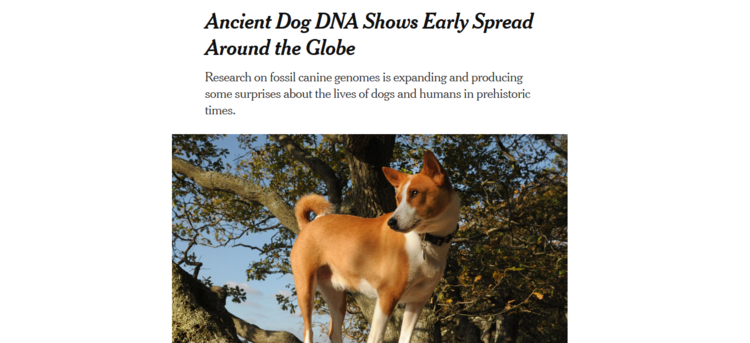Ancient Dog DNA Shows Early Spread Around the Globe
Research on fossil canine genomes is expanding and producing some surprises about the lives of dogs and humans in prehistoric times.
By James Gorman
Oct. 29, 2020, 2:00 p.m. ET
… The new report in the journal Science pushes ancient DNA studies of dogs to a new level, but raises as many questions as it answers. Until Thursday, scientists had published the genomes of only six ancient dogs and wolves. Now an international team of researchers has sequenced and analyzed an additional 27 genomes of ancient dogs.
David Reich, at Harvard University, who specializes in using ancient human DNA to understand migrations and population change, said the new research, “for the first time brings ancient DNA analysis of dogs to the kind of sophistication that exists with studies of humans” and other animals.
By 11,000 years ago, dogs had already diverged into five different lineages and spread worldwide. It is widely accepted that dogs were domesticated at least 15,000 years ago. The new study suggests, but doesn’t prove, that domestication probably began around 20,000 years ago.
Dogs probably evolved from an extinct form of wolf, yet to be identified. …
Ancient dogs were much more diverse genetically than modern dogs. Four thousand years ago, European dogs had a wide genetic diversity that disappeared long before the Victorians started creating new breeds. All European dogs appear to have descended from one group of ancient European dogs, and the great modern diversity of dog shapes and sizes indicates an emphasis by breeders on certain very powerful genes.
Dogs are a continuation of a line of wolves, but since those wolves became dogs more than 15,000 years ago, no new wolf DNA has entered dog genomes. This puzzles researchers because humans crossbred dogs and wolves, but none of the wolf DNA survived in dogs at large. Modern wolves, however, do show the incorporation of some dog DNA.
The geographic spread of dogs sometimes mirrors and sometimes diverges from human migration, leaving unanswered the effects of dog-trading and why the genes of particular populations of dogs sometimes extended and other times did not. …
By contrast, pigs, for example, were brought to Europe by farmers from Anatolia. But the genes of those first domesticated pigs have been completely lost, replaced by the genes of wild European boars, even though the pigs stayed domesticated animals.
While dogs do interbreed, no new wolf genes survive over the years. One possibility, Dr. Larson said, is that “wolfiness” just doesn’t fit with an animal as close to people as a dog. Pigs can be a little wild but “if you’re a dog and you’ve got a little bit of wolf in you, that’s not a good thing and those things get knocked on the head very quickly or run away or disappear but they don’t get integrated into the dog population.” …
Also migrations from the steppes changed human genomes in Europe, but had almost no effect on dog genomes. Conversely, migrations from the steppes eastward left an imprint on dog genomic history, but not on humans.
In Africa, ancient dogs were descended from dogs from the Middle East. But that did not parallel any human migration. The Basenji breed still has the majority of its ancestry from these Middle Eastern dogs.













